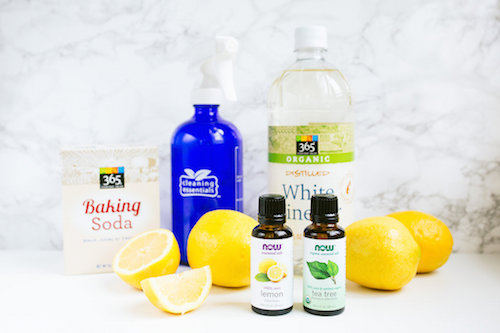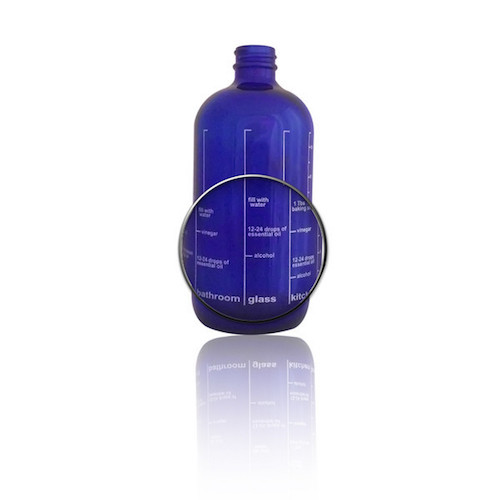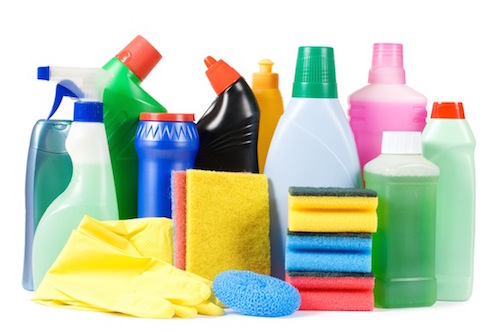
Well, hello. It is about 100 degrees right now, so I’m going to make this quick. No, really – our AC is out, and it is hotter inside our house than it is outside. And it’s not even summer yet! Which brings me to today’s topic: Spring (or early summer) Cleaning. Friends, family and readers ask all the time what brands they can trust when it comes to home cleaning. The truth is, not many. Even many of the brands that promote themselves as “eco-friendly” and “nontoxic” (you know the ones I”m referring to) are actually far from it. (In the industry, we call this “Green-Washing”.) As usual, Mother Nature does it best. I’ve tried a few times to make homemade cleaning solutions, but as you may know, I’m not exactly the best DIY-er. So, when Amanda from Be Home Well sent me the genius Cleaning Essentials Spray Bottle, I was actually both excited and relieved. This simple idea is about to make your domestic goddess duties much easier and A LOT less toxic.

The Cleaning Essentials Spray Bottle has 5 “recipes” printed on the side for tile, wood, bathroom, glass and kitchen. The clear bottle’s hashmarks show you how much of each ingredient you need to pour in – it could not be easier. And, I bet you have most of these ingredients in your home. The one I use most is the kitchen recipe. The kitchen is most definitely the heart of our home; with a young family and an open floor plan, someone is always in there. Our marble counters take a beating, and I’m sure there are some nasty germs on them, too. To keep them at bay, the kitchen recipe contains alcohol, (avoid isopropyl alcohol – cheap vodka works best and is safest) essential oils, (I like lemon and tea tree) distilled white vinegar, baking soda and water. Anti-microbial: check. Antibacterial: check. Real cleaning power: check. Nice, fresh smell: check. This (and the other recipes, as I tried them all) really worked!
I plan on buying 4 more bottles so that I have all the cleaning solutions on hand at all times. This way, I won’t have to make each solution every time I need it (not to mention dumping the remainder down the drain just so I can make a batch of something else). Buying the bottles and ingredients may sound like it could be expensive and time consuming, but I promise it is SO much cheaper than buying ready-made (usually toxic) household cleaners.

What’s wrong with conventional household cleaners? Surprise, surprise, the FDA doesn’t mandate that the manufacturers of household cleaners disclose the ingredients of their formulas on their packaging. Luckily, the EWG (Environmental Working Group) and has been testing many popular household cleaning formulas, and it released an updated Guide to Healthy Cleaning this spring. Give it a read; it’s not too long, and it’s really informative. Here are just a few of the toxic ingredients you will find in conventional household cleaners:
- Chlorine bleach (sodium hypochlorite): If mixed with ammonia, vinegar or other acid-based cleaners, it will release toxic chloramine gas; short-term exposure to this gas can cause mild asthmatic symptoms or more serious respiratory problems. Never mix bleach with these other substances.
- Petroleum distillates: Found in metal polishes, these chemicals can irritate the eyes and lungs; longer-term exposure can damage the nervous system, kidneys, eyes and skin.
- Ammonia: Can irritate eyes and lungs and cause headaches.
- Phenol and cresol: Found in disinfectants, and if ingested can cause diarrhea, fainting, dizziness, and kidney and liver damage.
- Nitrobenzene: Found in furniture and floor polishes, and if inhaled can cause shallow breathing; if ingested can cause poisoning and death. This substance has also been linked to cancer and birth defects.
- Formaldehyde: Used as a preservative in many household products, formaldehyde is a suspected human carcinogen that can irritate your eyes, throat, skin and lungs.
- Naphthalene: Found in mothballs, this suspected carcinogen may damage the eyes, blood cells, liver, kidneys, skin and the central nervous system.
- Paradichlorbenzene: Another chemical in mothballs, can harm the central nervous system, liver and kidneys.
- Hydrochloric acid or sodium acid sulfate: Found in toilet bowl cleaners, these chemicals can burn the skin and cause blindness if splashed in the eyes, or can burn the stomach if ingested.
- Fragrance or “Perfume”: We talk about this one all the time. I always say that in 20 years, we will look at synthetic fragrance the way we look at asbestos and cigarette smoke today – as to say it is TOXIC. It is 100% linked to endocrine disruption, reproductive and developmental harm, and it bioaccumulates in the human body.
Remember, it’s not about perfection – it’s about making small changes when you can. My suggestion would be to try the Cleaning Essentials Bottle (it’s only $16) and make the recipe for kitchen counters (you can also use it on bathroom counters and many other surfaces). If you find yourself using it a lot, and liking it, maybe purchase a few more bottles for other household cleaning.
That’s all for today. So, does the subject of household and home products interest you? Is it something you’d like me to talk more about here at Bare Beauty? I’ve weeded out every toxic hazard I know of in my home, especially since having Annabel. So, if it’s something you want to learn more about, let me know! I’m happy to share, and there is only so much beauty we can talk about! Stay cool, beauties.
…..
I’ve spent almost a decade immersed in the world of green beauty and nontoxic living. I want to help you find everything from a killer lipstick to a nontoxic laundry detergent, and beyond. Subscribe to a healthier lifestyle with me.

Thank you for subscribing!
